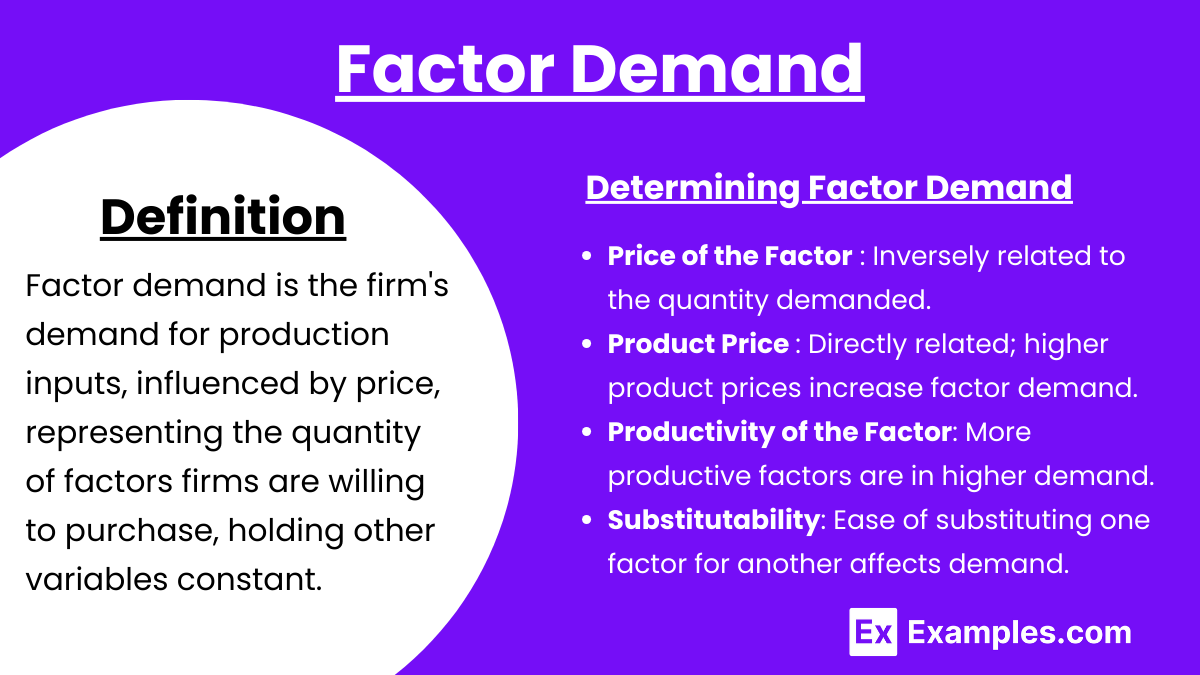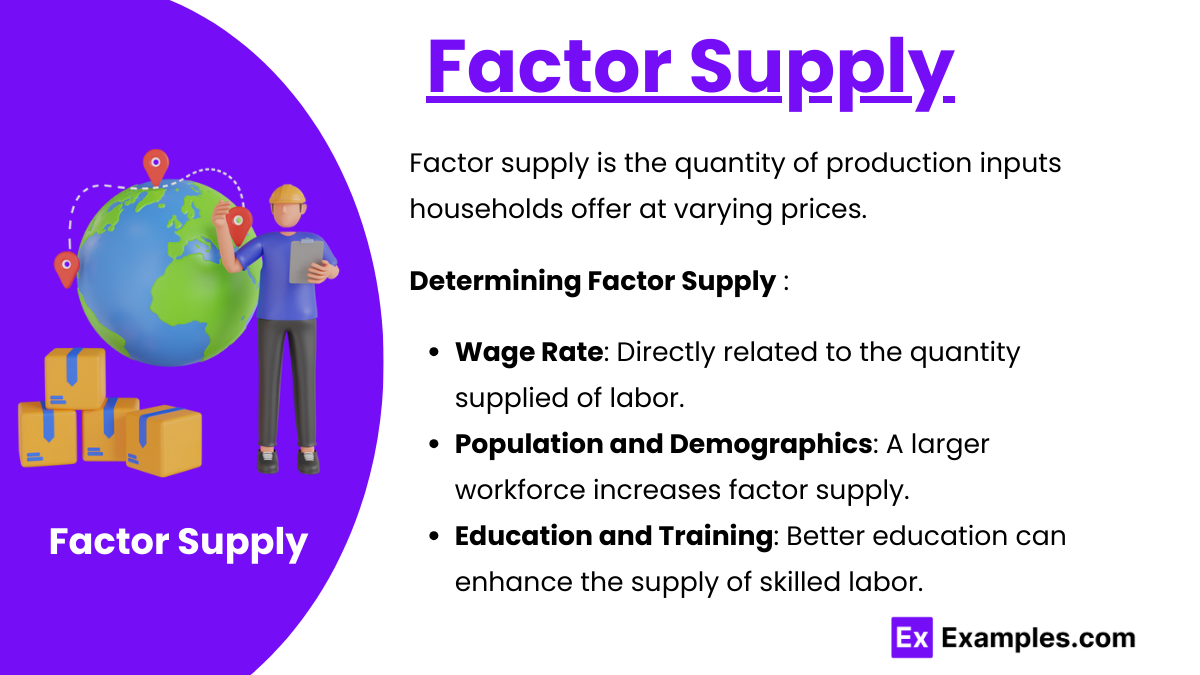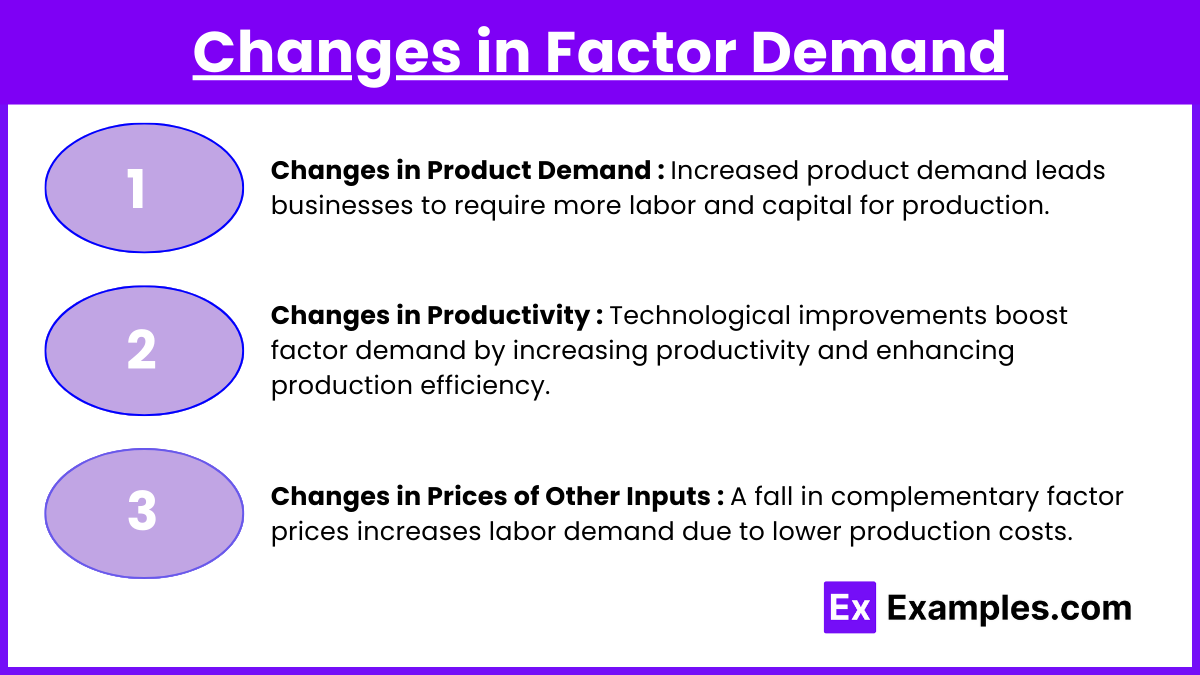In AP Microeconomics, changes in factor demand and factor supply are key concepts that explain how the markets for inputs like labor, land, and capital operate. Factor demand is derived from the demand for the goods and services that these inputs produce, while factor supply refers to the availability of these inputs. Various factors, such as shifts in product demand, technology, government policies, and population trends, can influence both demand and supply, impacting wages, employment, and resource allocation in the economy. Understanding these dynamics is critical for analyzing labor and capital markets.
Learning Objectives
When studying changes in factor demand and factor supply for AP Microeconomics, you should aim to understand the key determinants that cause shifts in the demand and supply of production factors like labor and capital. Focus on how changes in product demand, productivity, prices of related inputs, and government policies affect factor demand, while also considering factors like population changes, education, and alternative opportunities that influence factor supply. Finally, understand the effects these shifts have on wages, prices, and the equilibrium in factor markets.
1. Introduction to Factor Markets

Factor Markets are markets where factors of production (inputs like labor, capital, land, and entrepreneurship) are bought and sold. Unlike product markets, which deal with finished goods and services, factor markets focus on the inputs required to produce those goods and services.
Key Terms:
- Factor of Production: Inputs used to produce goods and services (e.g., labor, capital).
- Derived Demand: Demand for a factor of production is derived from the demand for the output it helps to produce.
2. Factor Demand

Factor Demand refers to the demand for a factor of production by firms. It represents the quantity of a factor that firms are willing and able to purchase at different prices, holding other factors constant.
Determining Factor Demand:
- Price of the Factor (Wage Rate for Labor): Inversely related to the quantity demanded.
- Product Price: Directly related; higher product prices increase factor demand.
- Productivity of the Factor: More productive factors are in higher demand.
- Substitutability: Ease of substituting one factor for another affects demand.
- Technology: Technological advancements can alter the demand for factors.
Graphical Representation
- Factor Demand Curve: Downward-sloping, illustrating the inverse relationship between factor price and quantity demanded.
Shifts in Factor Demand:
Factor demand curves can shift due to:
- Changes in Output Demand: Increased demand for a product raises factor demand.
- Changes in Productivity: Higher productivity makes factors more valuable, shifting demand right.
- Technological Changes: Can either increase or decrease factor demand depending on the nature of the technology.
- Price of Output: An increase in the price of the output raises factor demand.
- Prices of Other Inputs: If substitute inputs become cheaper, factor demand may decrease.
3. Factor Supply

Factor Supply refers to the supply of a factor of production that households are willing and able to offer at different prices, holding other factors constant.
Determining Factor Supply:
- Wage Rate: Directly related to the quantity supplied of labor.
- Population and Demographics: A larger workforce increases factor supply.
- Education and Training: Better education can enhance the supply of skilled labor.
- Alternative Opportunities: Availability of alternative employment affects labor supply.
- Government Policies: Taxes, subsidies, and regulations can influence factor supply.
Graphical Representation:
- Factor Supply Curve: Upward-sloping, indicating a positive relationship between factor price and quantity supplied.
Shifts in Factor Supply:
Factor supply curves can shift due to:
- Changes in Population: An increase in population shifts the supply curve right.
- Education and Training Improvements: Enhance the quality and supply of labor.
- Migration: Inflow or outflow of workers affects labor supply.
- Government Policies: Taxes on labor can decrease supply; subsidies can increase it.
- Social and Cultural Factors: Preferences for work vs. leisure can shift supply.
Changes in Factor Demand

Factor demand refers to the demand for inputs, such as labor, capital, and land, used in the production process. Factor demand is a derived demand, meaning it is driven by the demand for the goods and services that these inputs help produce. Several factors can cause shifts in the demand for factors:
- Changes in Product Demand:
- If the demand for the final product increases, businesses will demand more factors of production (like labor and capital) to produce more goods.
- Conversely, if demand for the product decreases, factor demand falls.
- Changes in Productivity:
- Improvements in technology or worker productivity can increase the demand for factors, especially if these improvements make production more efficient.
- If productivity decreases, businesses might need fewer factors to achieve the same output level, leading to a decline in factor demand.
- Changes in Prices of Other Inputs:
- If the price of a complementary factor (e.g., machinery for workers) falls, demand for labor might increase since it becomes cheaper to combine labor with capital.
- If a substitute factor (e.g., automation replacing workers) becomes cheaper, the demand for labor may decrease as firms opt for the substitute.
Changes in Factor Supply

Factor supply refers to the availability of inputs, particularly labor and capital, that can be used in the production process. Several factors influence changes in factor supply:
- Changes in Population:
- An increase in the working-age population (due to immigration, higher birth rates, etc.) increases the labor supply.
- A decrease in the labor force, such as aging or population decline, will reduce labor supply.
- Changes in Education and Training:
- More education and specialized training can increase the supply of skilled labor, shifting the supply curve to the right.
- Lack of education or access to training can limit the availability of skilled workers, reducing the factor supply.
- Changes in Alternative Opportunities:
- If better opportunities arise in alternative industries or regions, workers may shift, reducing the factor supply in the current industry.
- For example, an increase in wages in another industry or a region can pull workers away, reducing the local supply of labor.
Examples
Example 1. Technological Advancement in Manufacturing (Change in Factor Demand)
Scenario: A car manufacturing company adopts advanced robotics and automation technologies in its production line.
Explanation: The introduction of robotics significantly increases the productivity of capital (machinery) while reducing the reliance on unskilled labor. As a result, the demand for capital as a factor of production increases because each unit of capital can produce more cars efficiently. Conversely, the demand for unskilled labor decreases because machines are substituting manual tasks. Graphically, the factor demand curve for capital shifts to the right, indicating an increased demand at every price level, while the factor demand curve for unskilled labor shifts to the left, reflecting a decreased demand.
Example 2. Increase in Minimum Wage (Change in Factor Supply and Demand)
Scenario: The government implements a higher minimum wage law in the retail sector.
Explanation: Raising the minimum wage directly affects the labor market. From the supply side, higher wages make work more attractive, encouraging more individuals to supply labor, thereby shifting the labor supply curve to the right. However, from the demand side, employers face higher labor costs, which may lead them to hire fewer workers, shifting the labor demand curve to the left. The net effect could result in a new equilibrium with a higher wage rate but uncertain changes in employment levels, potentially leading to unemployment if the supply increase outpaces the demand decrease.
Example 3. Education and Training Programs (Change in Factor Supply)
Scenario: A government invests heavily in vocational training and higher education programs for the technology sector.
Explanation: Enhanced education and training increase the quality and quantity of skilled labor available in the technology sector. This expansion in the supply of skilled workers shifts the labor supply curve to the right, as more individuals are now qualified and willing to work in this field. With an increased supply of skilled labor, assuming demand remains constant, the equilibrium wage for skilled workers may decrease, and the quantity of labor employed in the technology sector would increase. This scenario benefits firms by providing a larger pool of talented employees, potentially fostering innovation and growth.
Example 4. Rise in the Price of Steel (Change in Factor Demand)
Scenario: Global events cause a significant increase in the price of steel, a key input for construction and manufacturing industries.
Explanation: Steel is an essential factor of production for industries like construction and automotive manufacturing. An increase in the price of steel raises the cost of production for these industries. As a result, firms may seek to reduce their use of steel by substituting it with cheaper alternatives or by improving efficiency, leading to a decrease in the demand for steel as a factor of production. Graphically, the factor demand curve for steel shifts to the left, indicating a lower quantity demanded at each price level. This shift can lead to reduced production in steel-intensive industries and potential layoffs if firms scale back their operations.
Example 5. Population Growth (Change in Factor Supply)
Scenario: A country experiences a significant population boom, particularly among working-age individuals.
Explanation: An increase in population, especially within the working-age demographic, boosts the overall supply of labor in the economy. This shift in the labor supply curve to the right means that more workers are available at every wage level. If the demand for labor remains unchanged, the increased supply may lead to downward pressure on wages, as employers have a larger pool of workers to choose from. Alternatively, if the economy is growing and demand for goods and services increases, the higher labor supply can support expansion without necessarily reducing wages. This scenario highlights the interplay between labor supply growth and economic conditions in determining wage levels and employment rates.
Multiple Choice Questions
Question 1
What is most likely to cause an increase in the demand for labor in a specific industry?
A) A decrease in the demand for the final product produced by the industry.
B) A decrease in the productivity of workers.
C) An improvement in technology that makes workers more efficient.
D) An increase in the availability of substitute capital.
Answer: C) An improvement in technology that makes workers more efficient.
Explanation:

An improvement in technology that enhances worker productivity can lead to an increase in the demand for labor because businesses can produce more goods with the same number of workers or use labor more efficiently. This increased efficiency often leads to greater production, which in turn drives up the demand for labor to meet higher production goals.
In contrast:
- A) A decrease in the demand for the final product would reduce the demand for labor, as less production is needed.
- B) A decrease in worker productivity would make labor less attractive, reducing labor demand.
- D) An increase in the availability of substitute capital (e.g., machinery) could decrease the demand for labor if businesses substitute workers with machines.
Question 2
Which of the following would lead to a decrease in the supply of labor in a particular industry?
A) An increase in wages in a competing industry.
B) A decrease in the cost of capital equipment.
C) A decrease in the population of working-age individuals.
D) An increase in government subsidies for businesses in the industry.
Answer: C) A decrease in the population of working-age individuals.
Explanation: A decrease in the population of working-age individuals directly reduces the available labor supply. Fewer people means fewer workers available to meet the needs of the industry, shifting the labor supply curve to the left.
In contrast:
- A) An increase in wages in a competing industry would reduce the labor supply in the current industry as workers move to the higher-paying jobs, but this is an indirect factor.
- B) A decrease in the cost of capital equipment may increase the demand for capital, but it does not directly affect labor supply.
- D) An increase in government subsidies for businesses may increase demand for labor but does not affect the supply of labor directly.
Question 3
What happens when the demand for a product rises, assuming other factors remain constant?
A) The demand for factors of production used to make the product will increase.
B) The supply of factors of production used to make the product will increase.
C) Wages in the industry producing the product will decrease.
D) The price of the product will decrease.
Answer: A) The demand for factors of production used to make the product will increase.
Explanation: When the demand for a product rises, firms will need to produce more of that product to meet the increased demand. This will cause an increase in the demand for the factors of production (e.g., labor, capital) that are used to produce the product, as firms need more inputs to ramp up production.
In contrast:
- B) The supply of factors of production will not automatically increase unless external factors, such as population growth or increased education, occur.
- C) Wages in the industry are likely to rise, not decrease, as firms compete for a limited supply of labor to meet higher production needs.
- D) The price of the product is more likely to increase due to higher demand, rather than decrease.


